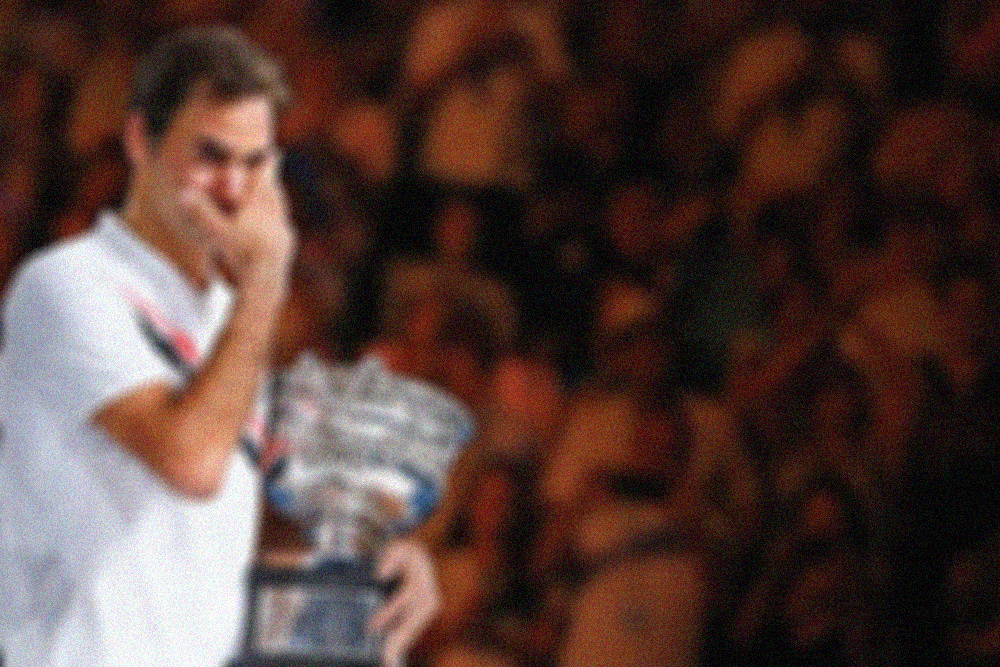Roger Federer : Tears of Glory
by Barry Black
Yes, it seems the world loves Roger Federer. It’s always a delight to see the greatest that’s ever played, and likely the best that will ever be in the sport of tennis. He is at times supernatural. It’s his mastery of the game both in the physical and psychological sense that is outstanding; what is most remarkable about the sport is the balance needed in both, each at an incalculably intense level, season after season.
Both on and off the court, tennis is one of the more isolating of sports. As players are not part of a team and league in the traditional sense, the tour becomes a personal enterprise involving independent gumption. The independence off the court also translates on the court, where the demands of the athlete become multitudinous. Tennis is a sport that demands from its top players a rare combination of competencies found in many other professional sports. For starters, a tennis player is not part of a team of athletes, rather they are the sole author of their athletic destiny, scrutinized for every action on (and off) the court, and taking complete responsibility for every loss. Consider the unforgiving language unique to tennis: an “unforced error” deems that only the athlete is to blame as a result of their incompetence, while also taking responsibility for every “double fault” or the rarer “foot fault” as self-imposed punishment and of course each missed stroke in match play. In golf, the most difficult hurdle is never the course, but one’s own mental composure. In tennis, pressures are multilayered, where an athlete has to compete on various surfaces and against opponents who possess skills that attempt to undermine one’s abilities; but the most difficult of obstacles is having to pay servitude to the behests of their own thoughts––mostly those couched in doubt.
As much as tennis requires physical prowess, the sport can also drive the mind to unspeakable frustration. Players staring into the nylon netting of their racket between points murmuring uncertainties are simply trying to understand why their brain failed to recognize a request to have their wrist angled at a particular midair point. This usually follows with a glance towards the coach’s box where the player’s team of supporters are rendered helpless as spectators. Doubt is the agent of their demise and something not so easily shared by the lone tennis player. So much of the pressures are internalized in tennis, and their release, like many of the frustrations, tend to manifest themselves in different ways––having a discussion with your racket is one of them. Part of Federer’s appeal and success is how well he hides his frustrations, at times adopting the disposition of an assassin. The mental anguish of players is something to behold; the Ivanišević-like tantrums that can occupy the spaces of courts for a player are no different than a sequence of aces in how they can completely turn or narrate a match. Ivanišević, Lendl and Becker, were all known to have meltdowns on the court that cost them a championship or two.
The meltdowns were at times unbearable to watch. Their tennis skills were incredible, at times almost unmatched, but what defeated them in those moments was the inability to cope with anxiety, their thoughts misguiding them with every hit of the ball. In tennis, it’s the long seasons and the endless losses that never deliver a championship that can bog down most from ever continuing. The tour demands that an athlete spend most of their time in hotels before competing in major tournaments in various foreign cities, while hitting a ball ad nauseum with an instructor somewhere in between.  In some ways, and to a lesser degree, a tennis player’s devotion is reminiscent of Bobby Fischer’s fervour to the game of chess and his isolation prior to his world championship. Bobby spent most of his time in hotels at the height of his chess career, while also adhering to a strict workout regimen. He spent it alone, poring over books on chess theory, getting lost in his thoughts, anticipating his opponents moves weeks before they were ever made. The isolation for Bobby, who famously said, “I don’t believe in psychology, I believe in good moves” ironically became his psychological undoing; despite taking every precautionary step to becoming a world champion, his move towards isolation meant forgoing other areas of healthy living. Luckily, for professional tennis players, the potential to isolate oneself isn’t nearly as possible; however, assiduous practice, staying in shape, and the psychological fortitude needed to reach the upper echelons of professional tennis are equal in undeterred focus and determination.
In some ways, and to a lesser degree, a tennis player’s devotion is reminiscent of Bobby Fischer’s fervour to the game of chess and his isolation prior to his world championship. Bobby spent most of his time in hotels at the height of his chess career, while also adhering to a strict workout regimen. He spent it alone, poring over books on chess theory, getting lost in his thoughts, anticipating his opponents moves weeks before they were ever made. The isolation for Bobby, who famously said, “I don’t believe in psychology, I believe in good moves” ironically became his psychological undoing; despite taking every precautionary step to becoming a world champion, his move towards isolation meant forgoing other areas of healthy living. Luckily, for professional tennis players, the potential to isolate oneself isn’t nearly as possible; however, assiduous practice, staying in shape, and the psychological fortitude needed to reach the upper echelons of professional tennis are equal in undeterred focus and determination.
After Federer won an unprecedented 20th Open title in Australia, we were witness to an outpouring of emotions that seemed to come out of nowhere. It is here that we witness Federer’s release from his vocational undertaking: the pool of emotional buildup––consistently buttressed by those in tennis determined to be the greatest––at some point spills its banks. In Federer’s case it was quite literal as he could hardly levee the tears from streaming. The incessant desire to be the greatest at any given profession is tantamount to a pathology, and Federer’s emotional response at his 20th Open victory was testament to its release and ultimately to sacrifice. Champions aren’t born, they’re made, and their stories involve a great deal of sacrifice. Compromises made by Roger have also been made by his wife and family, and the trainers and doctors who are all along for the journey. Federer’s 20th Grand Slam title is unprecedented in men’s professional tennis, and he’s fully aware of what it all means, especially as he sees the closing chapters of his career nearing their end. There’s no question that Federer has talent, something beyond the mouldings of honing one’s physical capabilities, but talents are nothing if not nourished. Behind the Rolex ads, and the Nike endorsements, is decades of sacrifice and other life losses that most aren’t willing to make or able to comprehend. It’s understood that Roger started to play sports at the tender age of 8, but at 12, his sole interest became tennis. One can only imagine that from the age of 12 to his mid-thirties that his life has likely been little more than practicing virtually every day, while forgoing other parts of a normal young adult life. Federer’s tears are the manifestation of decades of accumulated pressures and imposed limitations, voices of doubt, of goals that will never be, awareness of his inevitable decline due to age, and to all that says, “It cannot be”. In his victory speech at the Australian Open, Federer made a concerted effort to acknowledge the play of his opponent, recognizing the tournament organizers, and even his opponent’s coaching staff. Eventually, his acknowledgments led to those who have sacrificed for his victory, namely his family and coaches. And in a sudden burst, he broke his composure, clutching the Norman Brookes Challenge Cup, his voice cracked and eyes welled looking at his wife Mirka and the rest of his team. It was as though something was owing, a debt not only to them but to his adoring fans and perhaps to himself and to the doubts that linger. While having set so many records, Federer’s career appeared to be taking a turn for the worse in his early thirties, the kind of gradual descent expected of professional tennis players at that age. At 36, he’s found ways to deal with the gruelling schedule and has managed to defeat a long line of ardent opponents when everything that is known about the game would suggest this is impossible.

To watch Federer is to watch an elegant display of physicality. Take into consideration the devotion to the physical refinement of the sport, which one would equate to something like that of a professional ballet dancer. From stretching and leaping in perfectly timed unison to every opponent’s shot––where margin for error is impossible to understand for a mere spectator––one is simply in awe of the seemingly instinctual reactions required to compete at his level. Federer’s backhands are mesmerizing, and Rodinesque in their innate beauty. The mix of ability and desire becomes an art, something beautiful in its performance and also in its abstract, where I would unabashedly lend the word ‘majestic’ to describe it. What Federer has done in the sport is almost mythical. He has perfected his game where it almost seems instinctual in its precision, his execution so exquisite, it seems incapable of ever being thwarted. To have won three of the last four majors in this era of tennis at his age is more than remarkable. In this sense, as well as reaching 20 major wins, Federer has also created a new benchmark by pushing the plateauing age of a professional tennis athlete beyond what was normally understood as the line of no return.
In the 2017 Wimbledon final, Cilic lost swiftly to Federer, and by losing in such a manner, one understands how difficult it is to win at that level, and when a championship is won, it’s always deserved. This coming Wimbledon will likely be Roger’s last best chance at lifting the Gentlemen’s Singles Trophy at Centre Court. It’s unimaginable that at next year’s tournaments, at the age of 37, Federer will be able to maintain his skills, with young growing stars like Shapovalov, Zverev and others on the cusp of bigger things, alongside a long list of others waiting for their turn at glory. With Wimbledon not far off, one can already smell the cut grass; taste the strawberries and cream; see the ivy draped walls; and hear the roar of the crowd echoing inside the All England Club. Despite what felt like Federer becoming more aware of his age as a professional athlete, and hinting that the late night championship match took some toll mentally and perhaps physically, only doubt can prevent Federer’s chances of getting his 21st Open title. His tears were not a farewell, or a sign of mourning. He’s simply self-aware of the sacrifices it takes to win, and the love he has for the game, which perhaps rivals how much we love to watch him win.

